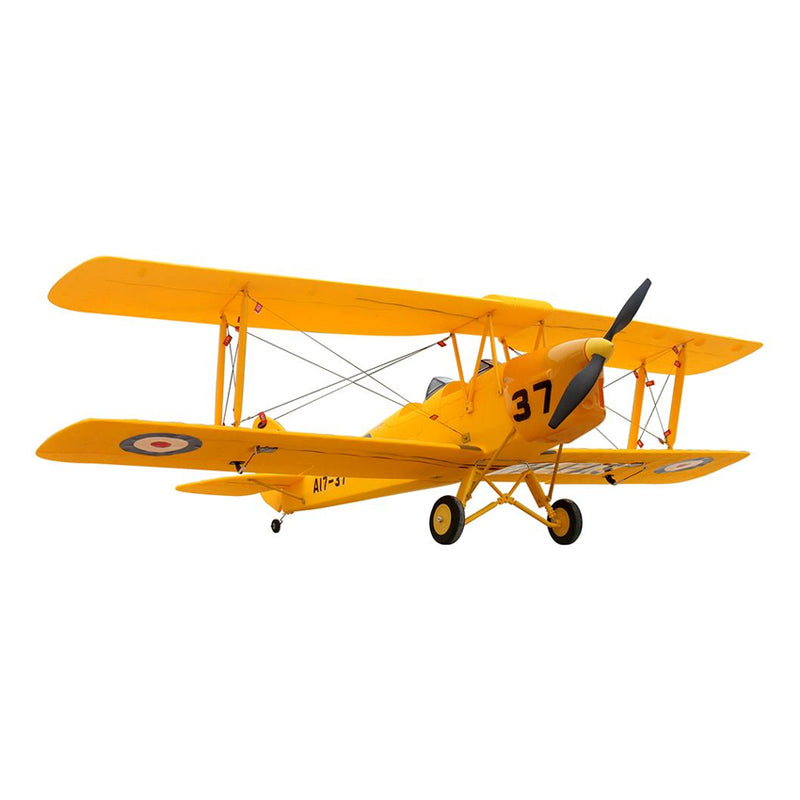Flying RC airplanes is a thrilling and rewarding hobby that requires precision, skill, and understanding of your aircraft’s unique characteristics. One of the most critical aspects of flying is mastering takeoff and landing—these are the moments when the most control and focus are required. In this article, I’ll share tips on how to master these essential maneuvers, focusing specifically on Dynam RC airplanes, with a detailed look at the Dynam Tiger Moth DH.82 V2 Yellow 4S RC Biplane.

The Importance of Takeoff and Landing in RC Flight
Takeoff and landing are often the most challenging parts of flying an RC airplanes. Unlike larger aircraft, RC planes are much lighter and require careful handling during these phases to avoid damage and ensure smooth operation. Mastering these maneuvers not only enhances your flying experience but also boosts your confidence and makes you a safer, more skilled pilot.
Step 1: Preparing for Takeoff
Before you even start your engine, ensure your RC plane is properly set up. This includes checking the battery, control surfaces, and receiver. Proper calibration of your transmitter and aircraft is essential to avoid issues during takeoff. For models like the Dynam Tiger Moth, it’s also important to check the plane’s control throws and trim settings to ensure everything is in place.
Pre-Takeoff Checklist:
- Battery Level: Always ensure your battery is fully charged and properly installed.
- Control Surfaces: Check the ailerons, elevators, rudders, and throttle for proper movement.
- Wind Conditions: Takeoff into the wind for better lift and control.
For the Dynam Tiger Moth DH.82 V2, a biplane with a 1300mm wingspan, the plane’s lightweight design and high lift capacity make it ideal for beginners. The Tiger Moth’s stable and forgiving nature during takeoff makes it a great choice for those still refining their skills.
Step 2: The Takeoff Process
When you’re ready to take off, gently advance the throttle. With the Dynam Tiger Moth, I’ve found that a steady and gradual application of throttle is key. A sudden increase in speed can cause the plane to become unstable, especially during the initial takeoff roll. As the plane gains speed, maintain a slight up-elevator to ensure the nose lifts smoothly.
A common mistake is trying to pull up too quickly—this can cause the plane to stall. With the Tiger Moth, I recommend a gradual increase in pitch, allowing the plane to lift off at a natural angle. Keep your control inputs smooth and gentle.
Step 3: Mastering the Landing Approach
Landing is often the part that trips up even seasoned pilots. The key to a successful landing is approach planning. Start by identifying a clear area where you can land without obstruction. The approach should ideally be into the wind, just like your takeoff.
For the Dynam Tiger Moth, I prefer to fly a consistent approach that allows for gradual descent, using the throttle to control my altitude and speed. It’s important to maintain enough airspeed to keep control of the plane but not so much that it makes landing too fast or difficult. With the Tiger Moth, its slow flight capabilities make it easier to manage the approach and avoid a hard landing.
Step 4: The Final Approach and Touchdown
As you near the landing area, slowly reduce your throttle to allow the plane to descend gently. With the Dynam Tiger Moth, it’s crucial to keep a steady hand on the controls during the final descent. If you’re coming in too fast, you can reduce throttle further to ensure a smooth touchdown.
The final step is the most delicate—allow the plane to touch down with the main wheels first, then let the tailwheel settle gently. Keep the controls neutral as you touch the ground to avoid bouncing or flipping the aircraft.
Tips for Mastering Takeoff and Landing with Dynam Planes
- Slow and Steady: For planes like the Dynam Tiger Moth and other beginner-friendly models, keeping your throttle inputs steady and gradual is essential for smooth takeoff and landing.
- Use the Wind: Always try to take off and land into the wind for the best lift and control.
- Practice Low-Speed Maneuvers: Get comfortable flying at slower speeds during both takeoff and landing approaches. This helps prevent stalls and improves overall control.
- Be Patient: Don’t rush your takeoff or landing. Take your time and focus on smooth, deliberate control movements.
FAQ: Mastering Takeoff and Landing with RC Airplanes
Q1: What are the common mistakes to avoid during takeoff and landing?
- Over-controlling: Sudden, harsh inputs can destabilize the plane. Make sure to apply control inputs smoothly.
- Improper Approach Angle: Ensure your approach is gentle and at the right angle. A steep angle can lead to a hard landing, while too shallow an angle might cause you to miss your landing spot.
Q2: How can I prevent my RC plane from stalling during takeoff?
- Gradually apply throttle and keep the nose of the plane level. Avoid pulling up too quickly, as this can lead to a stall.
Q3: How do I handle crosswinds during takeoff or landing?
- Crosswinds can make landing tricky. In these conditions, it’s crucial to maintain a controlled bank angle during the landing approach to counteract the wind.
A Personal Experience: Flying the Dynam Tiger Moth DH.82 V2 Yellow 4S RC Biplane
Having flown the Dynam Tiger Moth DH.82 V2 Yellow 4S RC Biplane extensively, I can say that it’s one of the best RC airplanes for learning takeoff and landing. This biplane is known for its forgiving nature, and it’s ideal for building confidence in these critical maneuvers.
The Tiger Moth’s design is a perfect blend of stability and responsiveness. I’ve found that with this plane, once you get the hang of takeoff and landing, you can achieve smooth and consistent results every time. The model’s 1300mm wingspan provides excellent lift and stability, making it easier to handle during both takeoff and landing approaches. The 4S battery offers just the right amount of power to make the plane responsive but not overly fast, making it ideal for learning.
Conclusion
Mastering takeoff and landing with RC airplanes, especially Dynam models like the Dynam Tiger Moth, requires practice, patience, and understanding your plane’s unique characteristics. Whether you’re just starting out or you’re a more experienced pilot, following these guidelines will help you achieve smoother flights and avoid common mistakes. Remember, each flight is an opportunity to learn and refine your skills, so get out there, practice, and enjoy the experience.
Table: Key Features of the Dynam Tiger Moth DH.82 V2 Yellow 4S RC Biplane
| Feature | Specification |
|---|---|
| Wingspan | 1300mm |
| Battery | 4S 2200mAh LiPo |
| Motor | BM3720-KV850 brushless |
| Flight Time | 10-12 minutes |
| Control | 4-channel (Elevator, Aileron, Throttle, Rudder) |
| Recommended Skill Level | Beginner to Intermediate |
| Construction Material | Durable EPO Foam |
| Recommended Wind Conditions | Light to Moderate |
Mastering takeoff and landing with the Dynam Tiger Moth or any other Dynam model will give you a deeper understanding of your aircraft and a greater sense of accomplishment. The more you practice, the more confident you’ll become in your flying abilities.
